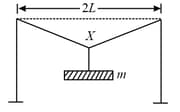MEDIUM
Earn 100
A uniform metallic bar of mass length and cross-sectional area is acted upon by force as shown in the figure acting along its length. There is no friction between the bar and the ground. Young's modulus of elasticity of the material of the bar is .


(a)
The longitudinal stress within the bar is uniform and has the value
(b)
The longitudinal stress within the bar is uniform and has the value
(c)
The longitudinal stress within the bar becomes zero, at the ends
(d)The average longitudinal strain in the bar is less than
50% studentsanswered this correctly
Important Questions on Elasticity
EASY
HARD
MEDIUM
EASY
EASY
HARD
A mild steel wire of length and cross-sectional area is stretched, well with in the elastic limit, horizontally between two pillars as shown in figure. A mass is suspended from the mid-point of the wire. Strain in the wire is

MEDIUM
HARD
EASY
MEDIUM
[Breaking stress of wire and area of cross-section of the wire]
MEDIUM
EASY
EASY
EASY
EASY
EASY
EASY
MEDIUM
[Given, the Young's Modulus for steel and brass are, respectively, and ]
MEDIUM
MEDIUM

